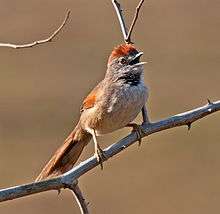Pale-breasted spinetail
The pale-breasted spinetail (Synallaxis albescens), is a passerine bird which breeds in the tropical New World from Costa Rica to Uruguay[2], and in Trinidad.
| Pale-breasted spinetail | |
|---|---|
 | |
| at Piraju, São Paulo State, Brazil | |
| Scientific classification | |
| Kingdom: | Animalia |
| Phylum: | Chordata |
| Class: | Aves |
| Order: | Passeriformes |
| Family: | Furnariidae |
| Genus: | Synallaxis |
| Species: | S. albescens |
| Binomial name | |
| Synallaxis albescens Temminck, 1823 | |
It is a member of the South American bird family Furnariidae, a group in which many species build elaborate clay nests, giving rise to the English name for the family of "ovenbirds".
However, the pale-breasted spinetail constructs a spherical stick nest with a 30 cm long tubular entrance low in a bush, into which its two greenish white eggs are laid. This species is a widespread and common resident breeder in a range of grassy and scrub habitats.
The pale-breasted spinetail is typically 16.5 cm long, and weighs 15 g. It is a slender bird with a medium long tail. The upperparts plumage is mainly pale brown, with darker wings and tail and rufous crown and shoulder patches. The throat and underparts are whitish with browner flanks.
Sexes are similar, but the race josephinae has grey on the forecrown, face sides and chest.
The pale-breasted spinetail is an insectivore which is difficult to see as it forages deep in thickets, but may be located by its buzzy repetitive wait'here song.
References
- BirdLife International (2012). "Synallaxis albescens". IUCN Red List of Threatened Species. 2012. Retrieved 26 November 2013.CS1 maint: ref=harv (link)
- Claramunt, Santiago; Mazzulla, J. C. (2002). "La presencia de Synallaxis albescens en Uruguay (Aves: Passeriformes: Furnariidae)" (PDF). Comunicaciones Zoológicas del Museo de Historia Natural y Antropología. 13 (200): 1–4.
- ffrench, Richard (1991). A Guide to the Birds of Trinidad and Tobago (2nd ed.). Comstock Publishing. ISBN 0-8014-9792-2.
- Hilty, Steven L (2003). Birds of Venezuela. London: Christopher Helm. ISBN 0-7136-6418-5.
External links
- Image - Animal Diversity Web
